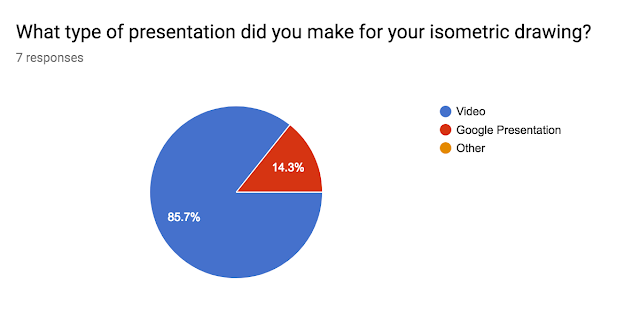During one of my
Manaiakalani ClassOnAir episodes, I had my class of Year 12 and Year 13 students create their own rewindable resources about sketching in isometric using the isometric grid sheets.
Blog post here
We put these resources on a
blog that was made especially for the purpose of students teaching skills and activities to others.
I wanted to know from the students what they thought of doing this kind of activity and if it was worth doing more of in the future.
Question 1
It is interesting to see that most of the students chose the video rather than the Google Presentation. The video is more of an immediate response where as the presentation means taking the pictures then producing the resource with them.
Question 2
It wasn't too hard to make the resource as they all know how to make videos using the iPads or make a presentation in Google.
The student who rated this at 2 made a video, and after talking to him, he did not find it easy to talk to the camera as he was drawing. He felt that his english was not clear enough.
Question 3
It is good to see that my examples and the fact that I was there added to the ease of this activity.
It is interesting to note that talking to the camera was the reason why one student found this easy while it was the main reason that another student did not find this easy at all even though his confidence in the actual drawing activity is high.
Question 4
I had a chat with the boys after they filled this form in for me to dig a bit deeper into what they were thinking. My feedback on this comes later in the post.
Question 5
Question 6
Not many of them did the analysis for me at the time, so I think some of the answers here are a bit of a "fib".... !!!! .. or maybe just a response to not having done it.
Question 7
After chatting with the boys, the Year 13 students who have done DVC (graphics) with me for the past 2 years are the ones who got the least out of this activity in terms of their personal learning. I think this is fair enough as they are already confident in their use of isometric sketching as I have made them do it for 2 years!!
Question 8
A mixed answer which is good. Some will use these, and these students are the ones who are new to DVC and have not had much experience in drawing in 3D. The others have much more experience so it is understandable that they will not use these for them selves at the moment.
Question 9
After the boys had filled in this Google Form for me (and during for some of them), we had a really interesting chat about the feedback that they give to their teachers. One of them admitted that he tried to say what he thought the teacher wanted to hear. Another was unsure of what to put as he did not find the exercise useful, so I had to reassure him that it was honesty that I was after.
I tried to stress with them that when teachers (laying emphasis on me at this point as it was me asking them for feedback at the time) ask them for feedback, it is to improve how the course was going. If something is not to their liking they need to say so on the feedback or they cant help things change and get better.
I used the example of last year, when 2 Year 12 boys gave me feedback that they didn't like the fact that I made the whole group research Art Deco instead of giving them a choice. The upshot of that was them helping me to design the Level 2 course for this year.
This then led to a conversation particularly with the student who had given me the most negative feedback.
He is a really good artist. He does Art at Level 3 too as well as DVC and doesn't feel the need to do drawing exercises like this to remind him of what to do. He did not like talking on camera while making his video as he does not feel confident about his language ability.
I asked him if he would feel better about it if he was making skills videos for the younger students, like the Year 9 and 10 classes. Again, he was not keen, with his reasons still being the talking on camera. When I gave him the suggestion of a silent video (or with music in the background) with written subtitles explaining what was happening, he was very keen. As I continue to use the blog we made for the students to use to remind themselves of skills, I will be asking him to make resources for the junior students to use.
It is great that a bit of potentially "negative" feedback has brought about a great conversation and a possible direction to go in in the future.




















